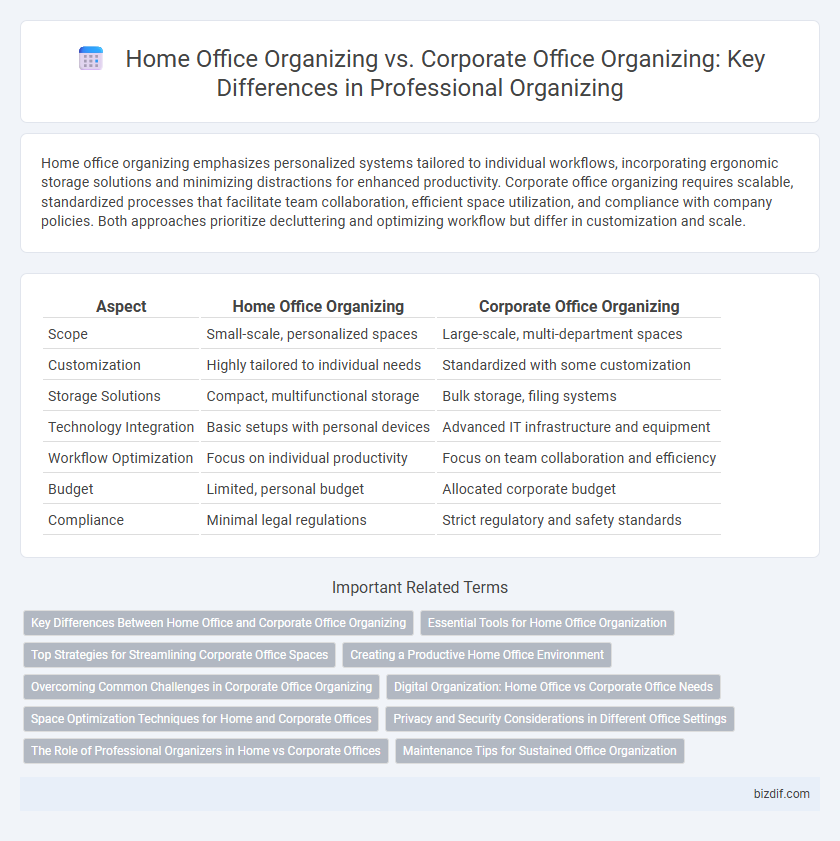Home office organizing emphasizes personalized systems tailored to individual workflows, incorporating ergonomic storage solutions and minimizing distractions for enhanced productivity. Corporate office organizing requires scalable, standardized processes that facilitate team collaboration, efficient space utilization, and compliance with company policies. Both approaches prioritize decluttering and optimizing workflow but differ in customization and scale.
Table of Comparison
| Aspect | Home Office Organizing | Corporate Office Organizing |
|---|---|---|
| Scope | Small-scale, personalized spaces | Large-scale, multi-department spaces |
| Customization | Highly tailored to individual needs | Standardized with some customization |
| Storage Solutions | Compact, multifunctional storage | Bulk storage, filing systems |
| Technology Integration | Basic setups with personal devices | Advanced IT infrastructure and equipment |
| Workflow Optimization | Focus on individual productivity | Focus on team collaboration and efficiency |
| Budget | Limited, personal budget | Allocated corporate budget |
| Compliance | Minimal legal regulations | Strict regulatory and safety standards |
Key Differences Between Home Office and Corporate Office Organizing
Home office organizing prioritizes personalized systems tailored to individual work habits, focusing on maximizing limited space and integrating personal items with professional needs. Corporate office organizing emphasizes standardized processes, scalability, and compliance with company policies to ensure efficiency across multiple users and departments. Key differences include the level of customization, volume of materials managed, and the balance between privacy and collaboration requirements.
Essential Tools for Home Office Organization
Essential tools for home office organization include ergonomic furniture, cable management systems, and versatile storage solutions tailored to limited spaces. Unlike corporate office organizing, home offices benefit from multi-functional desks, compact filing cabinets, and digital organization apps to streamline workflow. Prioritizing personalized organization tools enhances productivity and comfort in home-based professional environments.
Top Strategies for Streamlining Corporate Office Spaces
Maximizing efficiency in corporate office organizing requires strategic zoning, incorporating modular furniture, and implementing digital document management systems tailored to large teams. Prioritizing ergonomic workstations and collaborative spaces enhances productivity while reducing clutter and workflow interruptions. Leveraging cloud-based tools and standardized storage solutions streamlines communication and resource accessibility across departments.
Creating a Productive Home Office Environment
Creating a productive home office environment requires customized organization strategies that maximize limited space and minimize distractions, such as utilizing ergonomic furniture and efficient storage solutions. In contrast to corporate office organizing, which often involves standard layouts and shared resources, home office organizing emphasizes personalized workflows and technology integration to enhance focus and efficiency. Implementing clear zones for different tasks and maintaining clutter-free surfaces are essential to sustaining productivity in a home office setting.
Overcoming Common Challenges in Corporate Office Organizing
Corporate office organizing often faces challenges such as managing shared workspaces, coordinating across multiple departments, and maintaining standardized filing systems to ensure efficiency. Overcoming these issues requires implementing clear organizational policies, utilizing collaborative tools, and providing ongoing training to employees. A focus on adaptability and consistent communication helps sustain a productive and clutter-free corporate environment.
Digital Organization: Home Office vs Corporate Office Needs
Digital organization in a home office requires tailored solutions for personal device management, secure file storage, and streamlined communication tools suited to individual workflows. Corporate office digital organization emphasizes scalable cloud systems, enterprise-grade cybersecurity, and centralized data access to support collaborative projects and compliance standards. Both environments benefit from efficient digital asset categorization but differ significantly in scope and security protocols.
Space Optimization Techniques for Home and Corporate Offices
Space optimization techniques for home offices prioritize personalized storage solutions and ergonomic layouts to enhance comfort and productivity within limited square footage. Corporate office organizing emphasizes modular furniture systems, efficient use of shared workspaces, and technology integration to accommodate diverse team needs and maximize usable space. Both environments benefit from vertical storage, decluttering strategies, and strategic zoning to create functional, visually appealing work areas.
Privacy and Security Considerations in Different Office Settings
Home office organizing emphasizes personalized privacy controls and secure storage solutions tailored to individual needs, while corporate office organizing requires compliance with stringent data protection policies and secure access protocols to safeguard sensitive company information. In home offices, encryption and password management are critical for digital security, whereas corporate environments often implement multi-factor authentication and restricted access to confidential documents. Both settings must address cybersecurity risks and physical security, but corporate offices typically demand more robust, standardized measures to protect organizational assets and client data.
The Role of Professional Organizers in Home vs Corporate Offices
Professional organizers tailor strategies to enhance productivity and efficiency by decluttering and optimizing both home and corporate office environments. In home offices, they focus on personalized systems addressing limited space, blending work and living areas, and prioritizing ergonomics for remote work. Corporate office organizing involves coordinating with teams to implement scalable filing systems, streamline workflow processes, and maintain compliance with industry standards.
Maintenance Tips for Sustained Office Organization
Home office organizing requires personalized systems tailored to individual work habits, emphasizing regular decluttering and efficient use of limited space to maintain productivity. Corporate office organizing demands standardized maintenance protocols, consistent team collaboration, and clear labeling systems to ensure uniformity and smooth workflow across departments. Both settings benefit from scheduled organization reviews and digital tool integration to sustain long-term office efficiency.
home office organizing vs corporate office organizing Infographic

 bizdif.com
bizdif.com